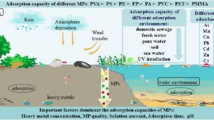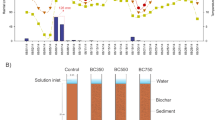Abstract
Three different types of zirconium-modified bentonites (ZrMBs) including zirconium-modified original bentonite (ZrMOB), zirconium-modified magnesium-pretreated bentonite (ZrMMgB), and zirconium-modified calcium-pretreated bentonite (ZrMCaB) were synthesized and used as active covering materials to suppress the release of phosphorus (P) from sediments. To assess the covering efficiency of ZrMBs to inhibit P release from sediments, we examined the impact of ZrMB covering layer on P mobilization in sediments at different depths as well as the release of P through the interface between sediment and overlying water (SWI) by use of simulating P release control experiments and diffusive gradients in thin films (DGT) technology. The results showed that the amount of soluble reactive P (SRP) in the overlying water greatly decreased after covering with ZrMBs. Moreover, both pore water SRP and DGT-liable P (DGT-P) in the top sediments decreased after capping with ZrMBs. An obvious stratification of DGT-P was observed along the vertical direction after covering with ZrMBs, and static and active layers were found in the top sediment and in the lower sediment directly below the static layer, respectively. Furthermore, ZrMB covering led to the change of P species from easily released P to relatively or very stable P, making P in the top sediment more stable compared to that without ZrMB covering. Besides, an overwhelming majority of P immobilized by ZrMBs is hard to be re-released into the water column in a common environment. Overall, the above results demonstrate that sediment covering with ZrMBs could effectively prevent the transport of SRP from sediments into the overlying water through the SWI, and the control of P transport into the overlying water by ZrMB covering could be mostly due to the immobilization of pore water SRP, DGT-P, and mobile P in the top sediment by ZrMBs.










Similar content being viewed by others
References
Berg U, Neumann T, Donnert D, Nüesch R, Stüben D (2004) Sediment capping in eutrophic lakes-efficiency of undisturbed calcite barriers to immobilize phosphorus. Appl Geochem 19:1759–1771
Burns EE, Comber S, Blake W, Goddard R, Couldrick L (2015) Determining riverine sediment storagemechanisms of biologically reactive phosphorus in situ using DGT. Environ Sci Pollut Res 22:9816–9828
Chen MS, Ding SM, Liu L, Xu D, Gong MD, Tang H, Zhang CS (2016) Kinetics of phosphorus release from sediments and its relationship with iron speciation influenced by the mussel (Corbicula fluminea) bioturbation. Sci. Total Environ. 542. Part A:833–840
Chen MS, Ding SM, Chen X, Sun Q, Fan XF, Lin J, Ren MY, Yang LY, Zhang CS (2018) Mechanisms driving phosphorus release during algal blooms based on hourly changes in iron and phosphorus concentrations in sediments. Water Res 133:153–164
Derakhshani E, Naghizadeh A (2018) Optimization of humic acid removal by adsorption onto bentonite and montmorillonite nanoparticles. J Mol Liq 259:76–81
Dils RM, Heathwaite AL (1998) Development of an iron oxide-impregnated paper strip technique for the determination of bioavailable phosphorus in runoff. Water Res 32:1429–1436
Ding SM, Han C, Wang YP, Yao L, Wang YY, Xu D, Sun Q, Williams PN, Zhang CS (2015) In situ, high-resolution imaging of labile phosphorus in sediments of a large eutrophic lake. Water Res 74:100–109
Ding SM, Sun Q, Chen X, Liu Q, Wang D, Lin J, Zhang CS, Tsang DCW (2018) Synergistic adsorption of phosphorus by iron in lanthanum modified bentonite (Phoslock®): New insight into sediment phosphorus immobilization. Water Res 134:32–43
Gao YL, Liang T, Tian SH, Wang LQ, Holm PE, Bruun Hansen HC (2016) High-resolution imaging of labile phosphorus and its relationship with iron redox state in lake sediments. Environ Pollut 219:466–474
Gibbs M, Özkundakci D (2011) Effects of a modified zeolite on P and N processes and fluxes across the lake sediment–water interface using core incubations. Hydrobiologia 661:21–35
Gu B-W, Lee C-G, Lee T-G, Park S-J (2017) Evaluation of sediment capping with activated carbon and nonwoven fabric mat to interrupt nutrient release from lake sediments. Sci Total Environ 599–600:413–421
Huang XJ, Shi WH, Ni JP, Li ZL (2017) Evaluation of laboratory-scale in situ capping sediments with purple parent rock to control the eutrophication. Environ Sci Pollut R 24:7114–7123
Ichihara M, Nishio T (2013) Suppression of phosphorus release from sediments using water clarifier sludge as capping material. Environ Technol 34:2291–2299
Kim LH, Choi E, Stenstrom MK (2003) Sediment characteristics, phosphorus types and phosphorus release rates between river and lake sediments. Chemosphere 50:53–61
Lin JW, Zhan YH, Zhu ZL (2011) Evaluation of sediment capping with active barrier systems (ABS) using calcite/zeolite mixtures to simultaneously manage phosphorus and ammonium release. Sci Total Environ 409:638–646
Lin JW, Wang H, Zhan YH, Zhang Z (2016) Evaluation of sediment amendment with zirconium-reacted bentonite to control phosphorus release. Environ Earth Sci 75:942–958
Lin J, Sun Q, Ding SM, Wang D, Wang Y, Chen MS, Shi L, Fan XF, Tsang DCW (2017a) Mobile phosphorus stratification in sediments by aluminum immobilization. Chemosphere 186:644–651
Lin JW, Zhan YH, Wang H, Chu M, Wang CF, He Y, Wang XX (2017b) Effect of calcium ion on phosphate adsorption onto hydrous zirconium oxide. Chem Eng J 309:118–129
Lin JW, He SQ, Zhan YH, Zhang HH (2018a): Evaluation of phosphate adsorption on zirconium/magnesium-modified bentonite. Environ. Technol. https://doi.org/10.1080/09593330.2018.1505966
Lin JW, Jiang BH, Zhan YH (2018b) Effect of pre-treatment of bentonite with sodium and calcium ions on phosphate adsorption onto zirconium-modified bentonite. J Environ Manag 217:183–195
Lin JW, Wang XX, Zhan YH (2018c) Effect of precipitation pH and coexisting magnesium ion on phosphate adsorption onto hydrous zirconium oxide. J Environ Sci. https://doi.org/10.1016/j.jes.2018.04.023
Liu Q, Ding SM, Chen X, Sun Q, Chen MS, Zhang CS (2018) Effects of temperature on phosphorus mobilization in sediments in microcosm experiment and in the field. Appl. Geochem. 88. Part B:158–166
Meis S, Spears BM, Maberly SC, O’Malley MB, Perkins RG (2012) Sediment amendment with Phoslock® in Clatto Reservoir (Dundee, UK): Investigating changes in sediment elemental composition and phosphorus fractionation. J Environ Manag 93:185–193
Meng YT, Ding SM, Gong MD, Chen MS, Wang Y, Fan XF, Shi L, Zhang CS (2018) Submillimeter-scale heterogeneity of labile phosphorus in sediments characterized by diffusive gradients in thin films and spatial analysis. Chemosphere 194:614–621
Mucci M, Maliaka V, Noyma NP, Marinho MM, Lürling M (2018) Assessment of possible solid-phase phosphate sorbents to mitigate eutrophication: influence of pH and anoxia. Sci Total Environ 619-620:1431–1440
Roberts EJ, Cooper RJ (2018) Riverbed sediments buffer phosphorus concentrations downstream of sewage treatment works across the River Wensum catchment. UK J Soil Sediment 18:2107–2116
Rodrigues LA, Maschio LJ, Cividanes Coppio LDS, Thim GP, da Caetano Pinto Silva ML (2012) Adsorption of phosphate from aqueous solution by hydrous zirconium oxide. Environ Technol 33:1345–1351
Rydin E (2000) Potentially mobile phosphorus in Lake Erken sediment. Water Res 34:2037–2042
Rydin E, Welch EB (1998) Aluminum dose required to inactivate phosphate in lake sediments. Water Res 32:2969–2976
Sen TK, Gomez D (2011) Adsorption of zinc (Zn2+) from aqueous solution on natural bentonite. Desalination 267:286–294
Smith VH, Tilman GD, Nekola JC (1999) Eutrophication: impacts of excess nutrient inputs on freshwater, marine, and terrestrial ecosystems. Environ Pollut 100:179–196
Song K, Adams CJ, Burgin AJ (2017) Relative importance of external and internal phosphorus loadings on affecting lake water quality in agricultural landscapes. Ecol Eng 108:482–488
Su Y, Cui H, Li Q, Gao SA, Shang JK (2013) Strong adsorption of phosphate by amorphous zirconium oxide nanoparticles. Water Res 47:5018–5026
Wang CH, Qi Y, Pei YS (2012) Laboratory investigation of phosphorus immobilization in lake sediments using water treatment residuals. Chem Eng J 209:379–385
Wang CH, Gao SJ, Pei YS, Zhao YQ (2013a) Use of drinking water treatment residuals to control the internal phosphorus loading from lake sediments: laboratory scale investigation. Chem Eng J 225:93–99
Wang CH, Liang JC, Pei YS, Wendling LA (2013b) A method for determining the treatment dosage of drinking water treatment residuals for effective phosphorus immobilization in sediments. Ecol Eng 60:421–427
Wang CH, Bai LL, Jiang HL, Xu HC (2016) Algal bloom sedimentation induces variable control of lake eutrophication by phosphorus inactivating agents. Sci Total Environ 557–558:479–488
Wang CH, He R, Wu Y, Lürling M, Cai HY, Jiang HL, Liu X (2017a) Bioavailable phosphorus (P) reduction is less than mobile P immobilization in lake sediment for eutrophication control by inactivating agents. Water Res 109:196–206
Wang Y, Ding SM, Wang D, Sun Q, Lin J, Shi L, Chen MS, Zhang CS (2017b) Static layer: a key to immobilization of phosphorus in sediments amended with lanthanum modified bentonite (Phoslock®). Chem Eng J 325:49–58
Wu ZH, Jiao LX, Wang SR (2016) The measurement of phosphorus, sulfide and metals in sediment of Dianchi Lake by DGT (diffusive gradients in thin films) probes. Environ Earth Sci 75:193
Xiong CH, Wang DY, Tam NF, Dai YY, Zhang XM, Tang XY, Yang Y (2018) Enhancement of active thin-layer capping with natural zeolite to simultaneously inhibit nutrient and heavy metal release from sediments. Ecol Eng 119:64–72
Yang MJ, Lin JW, Zhan YH, Zhang HH (2014) Adsorption of phosphate from water on lake sediments amended with zirconium-modified zeolites in batch mode. Ecol Eng 71:223–233
Yang MJ, Lin JW, Zhan YH, Zhu ZL, Zhang HH (2015) Immobilization of phosphorus from water and sediment using zirconium-modified zeolites. Environ Sci Pollut R 22:3606–3619
Yin HB, Kong M (2015) Reduction of sediment internal P-loading from eutrophic lakes using thermally modified calcium-rich attapulgite-based thin-layer cap. J Environ Manag 151:178–185
Yu JH, Ding SM, Zhong JC, Fan CX, Chen QW, Yin HB, Zhang L, Zhang YL (2017) Evaluation of simulated dredging to control internal phosphorus release from sediments: Focused on phosphorus transfer and resupply across the sediment-water interface. Sci Total Environ 592:662–673
Zhang Y, He F, Liu ZS, Liu BY, Zhou QH, Wu ZB (2016) Release characteristics of sediment phosphorus in all fractions of West Lake, Hang Zhou. China Ecol Eng 95:645–651
Zou YC, Grace MR, Roberts KL, Yu XF (2017) Thin ferrihydrite sediment capping sequestrates phosphorus experiencing redox conditions in a shallow temperate lacustrine wetland. Chemosphere 185:673–680
Acknowledgements
This research was jointly supported by the National Science Foundation of China (No. 50908142 and No. 51408354), Easysensor® scholar funding program, Shanghai Natural Science Foundation (No. 15ZR1420700), Shanghai Science and Technology Committee (No. 10230502900), and Shandong Key Scientific and Technical Innovation Project (No. 2018YFJH0902).
Author information
Authors and Affiliations
Corresponding author
Additional information
Responsible editor: Philippe Garrigues
Jianwei Lin and Yanhui Zhan contributed equally to this work.
Electronic supplementary material
ESM 1
(DOCX 137 kb)
Rights and permissions
About this article
Cite this article
Lin, J., He, S., Zhan, Y. et al. Assessment of sediment capping with zirconium-modified bentonite to intercept phosphorus release from sediments. Environ Sci Pollut Res 26, 3501–3516 (2019). https://doi.org/10.1007/s11356-018-3869-y
Received:
Accepted:
Published:
Issue Date:
DOI: https://doi.org/10.1007/s11356-018-3869-y




